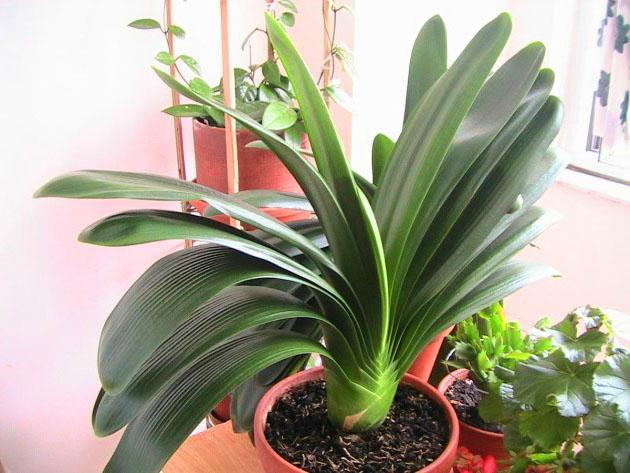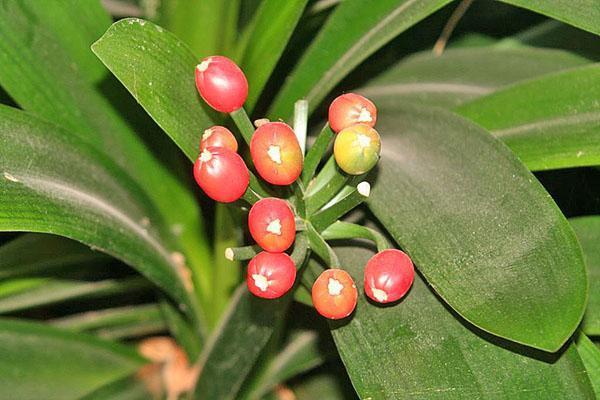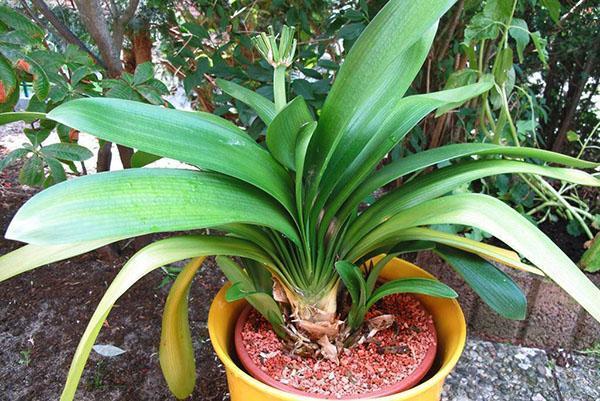We propagate clivia at home
 The tropical flower kaffir lily has long taken root on windowsills, and is loved by flower growers. Reproduction clivia (photo) at home they lead by root suckers and seeds. It has short, fleshy rhizomes, which, under good conditions, quickly give rise to lateral rosettes and create lawns. In captivity, the flower is propagated when transplanted into a new container. Clivia can be grown from seeds obtained from flowering plants after pollination.
The tropical flower kaffir lily has long taken root on windowsills, and is loved by flower growers. Reproduction clivia (photo) at home they lead by root suckers and seeds. It has short, fleshy rhizomes, which, under good conditions, quickly give rise to lateral rosettes and create lawns. In captivity, the flower is propagated when transplanted into a new container. Clivia can be grown from seeds obtained from flowering plants after pollination.
Receiving planting material
In a cramped root pot, there is not enough space. If you take a large dish while the roots fill it, there will be no flowering. In a close pots of fast-growing clivia, a transplant is necessary. The plant that has entered the flowering period forms shoots around, which are separated from the mother bush at the time of transplantation.

Read also the article: clivia - home care!
Requirement for dishes and soil
 Under natural conditions, clivia grows on fertile, humus-rich soil. Accordingly, a drainage layer is placed in the pot and a pillow from the substrate is poured:
Under natural conditions, clivia grows on fertile, humus-rich soil. Accordingly, a drainage layer is placed in the pot and a pillow from the substrate is poured:
- peat - 1 part;
- humus - 1 part;
- sod land –2 parts.
Additionally, perlite, or vermiculite and sand is added to the ground for clivia. Superphosphate in granules poured into the bottom of the pot will ensure better root development and abundant flowering.
Experienced flower growers use ready-made soil for orchids when transplanting. In such a substrate, the roots become greasy, the plant develops and blooms faster.
The pot for transplanting needs to be selected only slightly larger than the previous one. The choice of ceramic or plastic dishes depends on how easily and without injuries the plant is removed. Smooth inner plastic surfaces are preferred for this plant. The conical shape of the vessel will aid in easy extraction of the plant. Drainage holes should allow good drainage of irrigation water.
Clivia transplant at home
Unless there are circumstances that require immediate plant transplantation, clivia is transplanted after flowering, during a dormant period.
If you are not going to propagate the clivia from the seeds harvested from the plant, the flower arrow should be cut off. The plant is greatly weakened, giving strength to the production of offspring.
 When transferring, it is necessary to preserve the roots, since the wounds can become infected and the roots will begin to rot, especially since the plant likes abundant watering. Young plants are transplanted annually, while the old ones only change the top layer of the loosened soil. When planting in a new container, the soil layer should not cover the base of the leaves. Constant dampness in this area will lead to decay.
When transferring, it is necessary to preserve the roots, since the wounds can become infected and the roots will begin to rot, especially since the plant likes abundant watering. Young plants are transplanted annually, while the old ones only change the top layer of the loosened soil. When planting in a new container, the soil layer should not cover the base of the leaves. Constant dampness in this area will lead to decay.
If the roots are damaged during transshipment, they must be carefully treated with charcoal dust. The planted plant is shaded and creates comfortable conditions for rapid rooting.
 At the same time, new offspring can be gently disentangled from the mother plant for the reproduction of clivia. An indispensable condition will be the presence of at least four leaves in young plants.Only under this condition can the roots feed the young plant.
At the same time, new offspring can be gently disentangled from the mother plant for the reproduction of clivia. An indispensable condition will be the presence of at least four leaves in young plants.Only under this condition can the roots feed the young plant.
You can put young children in separate cups, with a bottom hole and a drainage layer. In this case, the diameter of the dish should be about 7 cm in diameter. You can root two or three plants in one pot. When clivia is reproduced at home by children, it will give a flower arrow for the second or third season.
It is considered important not to create a dormant period of two years for young plants. They must intensively throw out the leaves, accumulate a supply of food in order to bloom faster. Constant watering and feeding will accelerate the formation of an arrow.
Obtaining clivia from seeds.
 Seed propagation requires more patience. The seeds can be grown independently when the mother plant is eight years old. They need to be sown in a school made of peat, turf and sand. The seeds will hatch in six months. Favorable time for sowing from October to April. All the time the container is kept warm and slightly moisturized. After the leaf comes out, the plants are transferred into separate cups.
Seed propagation requires more patience. The seeds can be grown independently when the mother plant is eight years old. They need to be sown in a school made of peat, turf and sand. The seeds will hatch in six months. Favorable time for sowing from October to April. All the time the container is kept warm and slightly moisturized. After the leaf comes out, the plants are transferred into separate cups.
Seeds germinate if they were kept wet in the berry. So that the berry does not dry out, it is kept on the cut stem until the time of sowing.
There is also a faster way to get seedlings - in a warm place in a damp cloth. The hatched seeds are sown in separate cups.
After the seedlings grow up, they are transplanted into large cups and more nutritious soil. In two years, three transplanted plants without a dormant period gain mass and roots. They are fed, kept at a temperature of 200 C. With seed propagation of clivia at home, flowering will occur in the fourth year of the plant's life.
Good evening! Is it possible to plant a clivia shoot without roots using a root?
It is advisable to wait until the process has grown its roots. You can try. Give the plant a transparent cap so it takes root faster. The process will take a little longer.
"Young plants are transplanted annually, while the old ones only change the top layer of the loosened soil" - this means that another pot is not needed? And how can you tell if a plant is old?
Older plants usually grow in large pots and have a fairly strong root system with many roots intertwined with each other. It is almost impossible to remove them from the pot without damaging them. In this case, the transplant will do more harm than good to the flower. Therefore, it is recommended only to change the topsoil without removing the plant from the pot. Accordingly, a new flowerpot is not needed.
Hello, I have new shoots among the leaves, are these children or are they just new leaves growing?
More like a baby.
My clivia has been in the same state for 7-8 years already: on top there are always two short leaves (as a new leaf appears, the bottom one dies off), on the bottom 1-2 long fleshy roots, the rest dry up in dust (seen during transplantation). She stood in the sun and in the shade, and I feed her, and loosen it - what else does she want? It suffers, but it's a pity to throw it away
Try changing the soil to a more nutritious one. If it grows in a large pot, transplant it into a smaller one to start growing roots. Change fertilizers, maybe those that were previously applied are not very suitable for her. The plant does not completely disappear, which means that everything is not lost yet. You can also use a growth stimulant.
I have a piece of clivia root. Will I be able to grow a complete plant? Tell me how to be
Clivia reproduces vegetatively only with the help of children - young plants that have already acquired their own roots. Only in this case can they be separated from the mother bush and take root. If you have just a piece of a fleshy root, without an aerial part with leaves, then nothing will work. It will simply rot in soil or water, but it will not be able to give a new leafy socket on its own.
Tell me please, my clivia has thrown out the seeds for the second year now, and this bag is hanging. When should you cut and disperse these seeds. Navid is a dense green-red bag. Or you need to wait for it to soften
Hello! Is it possible to root a clivia leaf or part of it in the ground? Are there such options with clivia leaf? How to do it step by step, if it's real? Thank you in advance
Clivia reproduces vegetatively only by children or by dividing an adult bush. One leaf does not take root by itself, it will not be able to put down roots and will simply disappear in the pot.